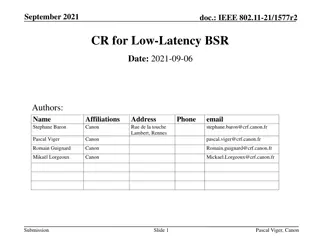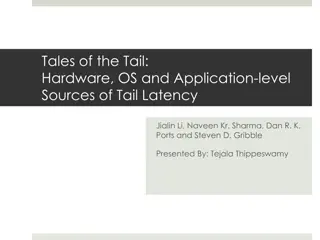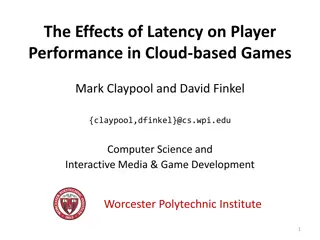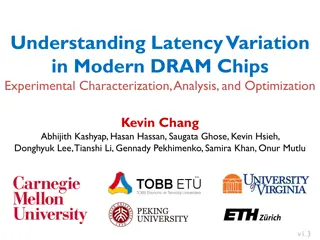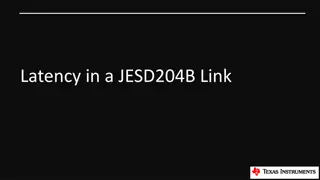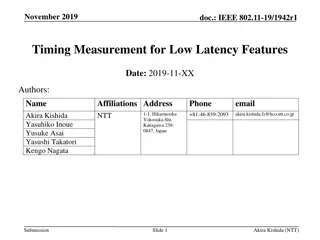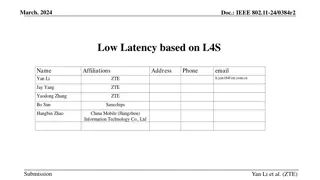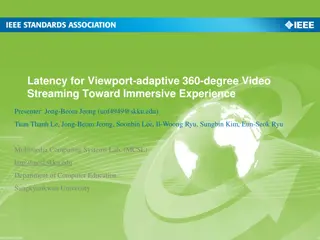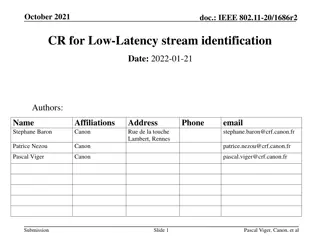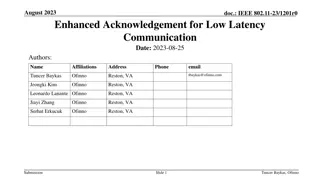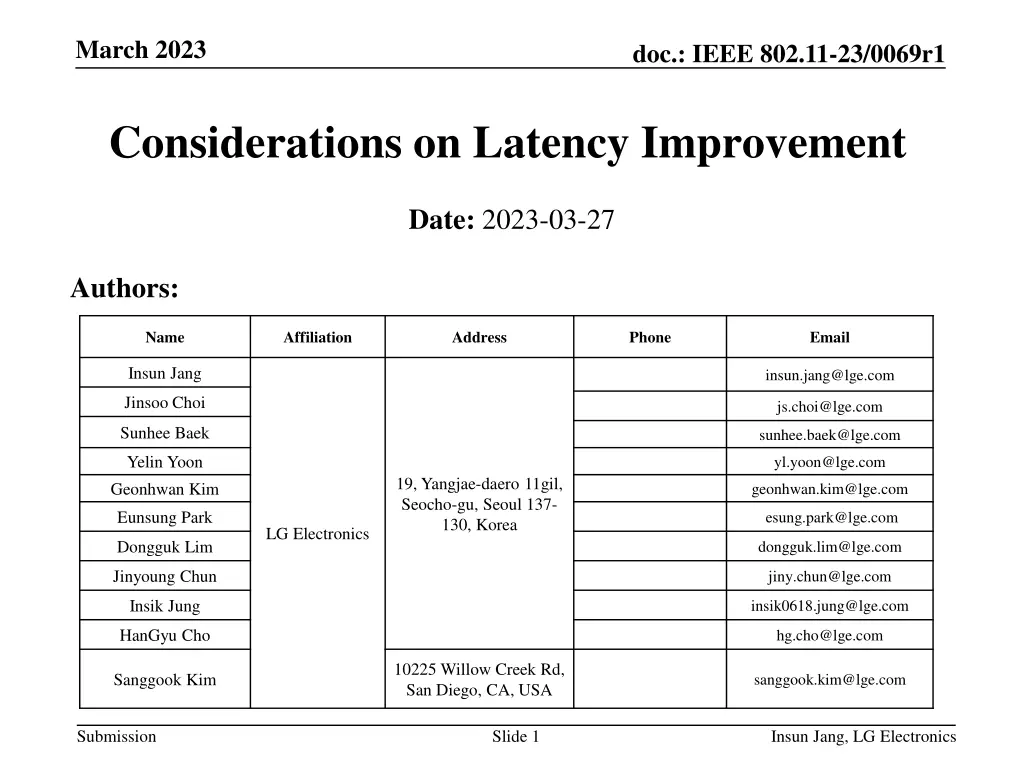
Improving Latency in UHR: Considerations and Requirements
Explore key considerations for enhancing latency in UHR technology, focusing on scheduling, preemption, and traffic requirements. Discusses the classification, prioritization, and scheduling of low latency traffic for improved performance in high-speed wireless networks.
Uploaded on | 2 Views
Download Presentation

Please find below an Image/Link to download the presentation.
The content on the website is provided AS IS for your information and personal use only. It may not be sold, licensed, or shared on other websites without obtaining consent from the author. If you encounter any issues during the download, it is possible that the publisher has removed the file from their server.
You are allowed to download the files provided on this website for personal or commercial use, subject to the condition that they are used lawfully. All files are the property of their respective owners.
The content on the website is provided AS IS for your information and personal use only. It may not be sold, licensed, or shared on other websites without obtaining consent from the author.
E N D
Presentation Transcript
March 2023 doc.: IEEE 802.11-23/0069r1 Considerations on Latency Improvement Date: 2023-03-27 Authors: Name Affiliation Address Phone Email Insun Jang insun.jang@lge.com Jinsoo Choi js.choi@lge.com Sunhee Baek sunhee.baek@lge.com Yelin Yoon Geonhwan Kim yl.yoon@lge.com 19, Yangjae-daero 11gil, Seocho-gu, Seoul 137- 130, Korea geonhwan.kim@lge.com Eunsung Park esung.park@lge.com LG Electronics Dongguk Lim dongguk.lim@lge.com Jinyoung Chun jiny.chun@lge.com Insik Jung insik0618.jung@lge.com HanGyu Cho hg.cho@lge.com 10225 Willow Creek Rd, San Diego, CA, USA Sanggook Kim sanggook.kim@lge.com Submission Slide 1 Insun Jang, LG Electronics
March 2023 doc.: IEEE 802.11-23/0069r1 Introduction Currently, we re targeting to improve the tail of the latency distribution and jitter as the main goal in UHR in the approved PAR [10] With the goal, several presentations [1]-[9] addressed in UHR SG have investigated Classification/Prioritization of low latency (LL) traffic [1] Preemption of LL traffic [2], [3], [9] Optimized Scheduling (considering the impact of OBSS) [4], [5] Frame/PPDU Overhead Reduction (in TXOP) [6]-[8] In this contribution, we share some considerations to improve the latency in UHR in terms of Scheduling and Preemption of LL traffic Submission Slide 2 Insun Jang, LG Electronics
March 2023 doc.: IEEE 802.11-23/0069r1 Requirements of Low Latency Traffic Dedicated Scheduling (Time-critical) LL traffic should be scheduled by assigning any dedicated resource/period without the contention with any other traffic The scheduling would depend on its characteristics (e.g., service interval, delay bound) To this end, we need to discuss how to classify LL traffic clearly Preemption (Time-critical) LL traffic should be scheduled by providing a priority and flexibility when incoming LL traffic has to be transmitted quickly To this end, we need to discuss how to preempt LL traffic We first observe baseline and then discuss some considerations for each one Submission Slide 3 Insun Jang, LG Electronics
March 2023 doc.: IEEE 802.11-23/0069r1 Observation on Baseline: Traffic Classification In the current baseline, traffic is classified as TID per MSDU based on priority parameter from Higher layer/DS which is mapped to the user priority (UP) and the corresponding Access Category (AC) Specially, TID 0-7 is used as TC while TID 8-15 is used as TS (e.g., in TSPEC) Further, the traffic characteristics can be configured/described in addition to TID/UP during (Multi-link) SCS procedure (i.e., through QoS Characteristics IE) Submission Slide 4 Insun Jang, LG Electronics
March 2023 doc.: IEEE 802.11-23/0069r1 Observation on Baseline: Scheduling Based on the baseline, we can utilize TID-based scheduling to schedule low latency (LL) traffic flow, e.g., In terms of multi-link, TID-to-link Mapping (T2LM) In terms of service period, restricted TWT (rTWT) through Traffic Info If SCS negotiation exists, its requirements can apply the scheduling However, we can have the following observations Per TID, an STA may have LL traffic and non-LL traffic as the same priority and multiple LL traffic with different characteristics It would be better for a specific LL traffic flow to be transmitted separately from non-LL traffic or another LL traffic with different characteristics on any dedicated resources Different STAs may have LL traffic with similar or different characteristics AP MLD has the global view of the traffic information (if negotiated) and can schedule LL traffic with similar characteristics on the same dedicated resources The current baseline is not enough to resolve those observations Submission Slide 5 Insun Jang, LG Electronics
March 2023 doc.: IEEE 802.11-23/0069r1 Consideration on LL Traffic Classification We can classify LL traffic by enhancing the current one, e.g., Identifying LL traffic per TID by making sub_IDs, i.e., 2-tuple <TID, sub_ID (e.g., LLT ID)> It maintains the current space of TID (0~7) AP can assign the sub_ID depending on traffic characteristics (e.g., when SCS negotiated) Extending available TID space (e.g., up to 15) It would require the modifications on higher layers to support the assignment By utilizing the classification We can transmit the identified LL traffic only on any dedicated link, SP with enhanced identification, or Triggered UL in a TXOP We can have an opportunity to access the channel or transmit quickly if a new queue/EDCA parameter set is introduced and applied Submission Slide 6 Insun Jang, LG Electronics
March 2023 doc.: IEEE 802.11-23/0069r1 Example: TID-to-link Mapping & R-TWT Scheduling Example assumes that TID N is mapped to link 1 and link 2 Submission Slide 7 Insun Jang, LG Electronics
March 2023 doc.: IEEE 802.11-23/0069r1 Observation on Baseline: AC Mapping We use a fixed UP-to-AC Mapping based on a given TID In other words, if a TID/UP is assigned to LL traffic is assigned, AC is determined based on the fixed table We may want LL traffic to be assigned to other AC(s) not fixed one by experiencing the cases, e.g., LL traffic TX may be delayed due to head-of-line (HOL) blocking in the queue of AC corresponding to the LL traffic There may be a chance to get a queue/AC which has almost no MSDUs queued or which has almost completed back-off to gain the channel access Some LL traffic may need to be assigned to AC (e.g., with higher priority) than its another fixed AC Submission Slide 8 Insun Jang, LG Electronics
March 2023 doc.: IEEE 802.11-23/0069r1 Consideration on AC Mapping for LL Traffic For the preemption of LL traffic for quick TX, we can consider the change of AC mapping dynamically rather than the currently fixed one One or more AC(s) may be mapped to LL traffic It may be able to apply to incoming LL traffic or already queued LL traffic Dynamic level and Negotiation/Signaling method should be investigated, e.g., Whether it can be applied to Per BSS, STA, or LL Traffic flow Submission Slide 9 Insun Jang, LG Electronics
March 2023 doc.: IEEE 802.11-23/0069r1 Conclusion In this contribution, we ve shared high-level thoughts to improve the latency in UHR in terms of Scheduling and Preemption of LL traffic Specifically, we ve investigated the classification of LL traffic for scheduling with dedicated resources and dynamic AC mapping for preemption of LL traffic, We need to further investigate in terms of many aspects, e.g., Proper level for classification/preemption of various LL traffic Complexity and Impact on existing implementation Submission Slide 10 Insun Jang, LG Electronics
March 2023 doc.: IEEE 802.11-23/0069r1 References [1] 22/1930r0, Layered QoS and multi-layer transmission [2] 22/1880r1, Latency and Reliability enhancements for UHR [3] 22/1393r0, Latency Reduction Scheme for UHR [4] 22/1899r0, Multi-AP Operation for Low Latency Traffic Delivery - Follow up [5] 22/1556r1, Multi-AP Coordination for Low Latency Traffic Delivery [6] 22/1926r0, Challenges to achieve low latency [7] 22/1923r1, Enhanced Trigger-Based Uplink Transmission [8] 22/1939r0, PPDU Design for Short Frames [9] 23/0018r1, Low latency support in UHR [10] 23/0480r0, UHR Proposed PAR Submission Slide 11 Insun Jang, LG Electronics

